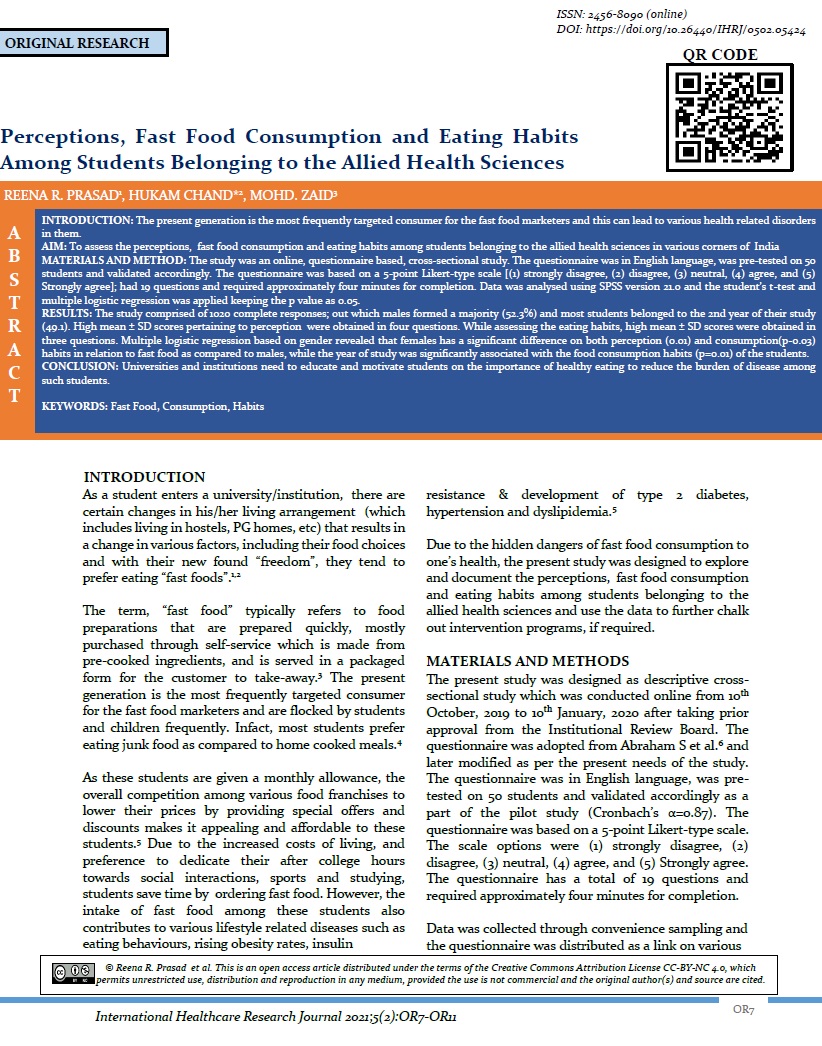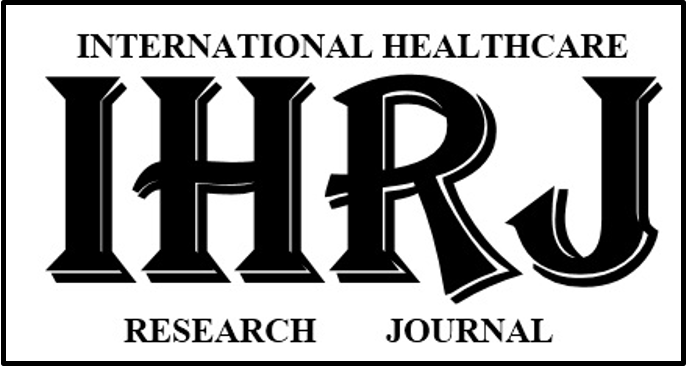Perceptions, Fast Food Consumption and Eating Habits Among Students Belonging to the Allied Health Sciences
Abstract
INTRODUCTION: The present generation is the most frequently targeted consumers for the fast food marketers and can lead to various health related disorders in them.
AIM: To assess the perceptions, fast food consumption and eating habits among students belonging to the allied health sciences in various corners of India.
MATERIALS AND METHOD: The study was an online, questionnaire based, cross-sectional study. The questionnaire was in English language, was pre-tested on 50 students and validated accordingly. The questionnaire was based on a 5-point Likert-type scale [(1) strongly disagree, (2) disagree, (3) neutral, (4) agree, and (5) Strongly agree]; had 19 questions and required approximately four minutes for completion. Data was analysed using SPSS version 21.0 and the student’s t-test and multiple logistic regression was applied keeping the p value as 0.05.
RESULTS: The study comprised of 1020 complete responses; out which males formed a majority (52.3%) and most students belonged to the 2nd year of their study (49.1). High mean ± SD scores pertaining to perception were obtained in four questions. While assessing the eating habits, high mean ± SD scores were obtained in three questions. Multiple logistic regression based on gender revealed that females has a significant difference on both perception (0.01) and consumption(p-0.03) habits in relation to fast food as compared to males, while the year of study was significantly associated with the food consumption habits (p=0.01) of the students.
CONCLUSION: Universities and institutions need to educate and motivate students on the importance of healthy eating to reduce the burden of disease among such students.
Downloads
References
Brevard PB, Ricketts CD. Residence of college students affects dietary intake, physical activity, and serum lipid levels. J Am Diet Assoc. 1996, 96: 35-8. https://doi.org/10.1016/S0002-8223(96)00011-9.
Kremmyda LS, Papadaki A, Hondros G, Kapsokefalou M, Scott JA: Differentiating between the effect of rapid dietary acculturation and the effect of living away from home for the first time, on the diets of Greek students studying in Glasgow. Appetite. 2008, 50:455-63. https://doi.org/10.1016/j.appet.2007.09.014.
Alfaris NA, Al-Tamimi JZ, Al-Jobair MO, Al- Shwaiyat, MN. Trends of Fast Food Consumption Among Adolescent and Young Adult Saudi Girls Living In Riyadh. Food Nutr Res. 2015;59:26488. 10.3402/fnr.v59.26488. eCollection 2015.
Sogari G, Velez-Argumedo C, Gómez MI, Mora C. College Students and Eating Habits: A Study Using An Ecological Model for Healthy Behavior. Nutrients. 2018;10(12):1823. https://doi.org/10.3390/nu10121823
Abdullah NN, Mokhtar MM, Bakar MHA, Al-Kubaisy W. Trend on Fast Food Consumption in Relation to Obesity among Selangor Urban Community. Procedia -Social and Behavioral Sciences 2015; 202:505–13. https://doi.org/10.1016/j.sbspro.2015.08.189
Abraham S, Martinez M, Salas G, et al. College student’s perception of risk factors related to fast food consumption and their eating. habits. J Nutr Hum Health. 2018;2(1):18-21.
Mahajan SA, Gothankar JS. Fast food consumption pattern amongst undergraduates of various disciplines of private colleges in Pune. Int J Community Med Public Health. 2020;7:505-11.
Bipasha MS, Goon S. Fast food preferences and food habits among students of private universities in Bangladesh. South East Asia J Public Health. 2013;3(1):61-4
Yarmohammadi P, Sharifirad GR, Azadbakht L, Yarmohammadi P, Rahaei Z, Bahrevar V, et al. The Association between Socio-Demographic Charactristics and Fast Food Consumption within High School Students in Isfahan, Iran. J Community Health Res. 2015;4(3):194-202.
Jaworowska A, Blackham I, Davies I, et al. Nutritional challenges and health implications of takeaway and fas food. Nutr Rev. 2013;71:310-8.
Deliens T, Clarys P, Bourdeaudhuij ID, Deforche B. Correlates of University Students’ Soft and Energy Drink Consumption According to Gender and Residency. Nutrients. 2015;7(8): 6550–6. 10.3390/nu7085298
Dingman D, Schulz M, Wyrick D, et al. Factors related to the number of fast food meals obtained by college meal plan students. J Am Coll Health. 2014;62:562-69.
De Vogli R, Kouvonen A, Gimeno D. Globesization: Ecological evidence on the relationship between fast food outlets and obesity among 26 advanced economies. Critical Public Health. 2011;21:395-02.
Shah T, Purohit G, Pillai NS, et al. Assessment of obesity, overweight and its association with the fast food consumption in medical students. J Clin Diagn Res. 2014;8:CC05-CC07.

Copyright (c) 2021 Reena R. Prasad et al.

This work is licensed under a Creative Commons Attribution-NonCommercial 4.0 International License.


